My friend Alan, personable owner of Hearts and Flowers in Charlottetown, invited me to speak to his regular Wednesday morning “breakfast club” this week. The club, which meets for breakfast every morning at the Rodd Royalty hotel, is an interesting cross-section of Charlottetown businesspeople; it’s a testament to how small a place this is that around the table were the guy who sold me my life insurance, the guy I get my auto insurance from, and someone whose son I once hired.
They meet to socialize, talk about business, and generate “leads,” the later a concept that, thank goodness, I’ve a stable enough client base to be completely unfamiliar with.
I joked with them that I’d always suspected there was a secret cabal meeting in a hotel that actually ran the city; while I was exaggerating, I’d imagine that with the collected knowledge and resources of the people around that breakfast table you could get an awful lot done.
Alan asked me to come in and speak for 20 minutes about “what it is that I do,” a notion that threw me into a temporary existential crisis – what do I do? do I actually do anything? I managed to pull out a common thread joining together enough of the things that I do to turn into a 20 minute encapsulation, boiled down to its essence in this infographic:
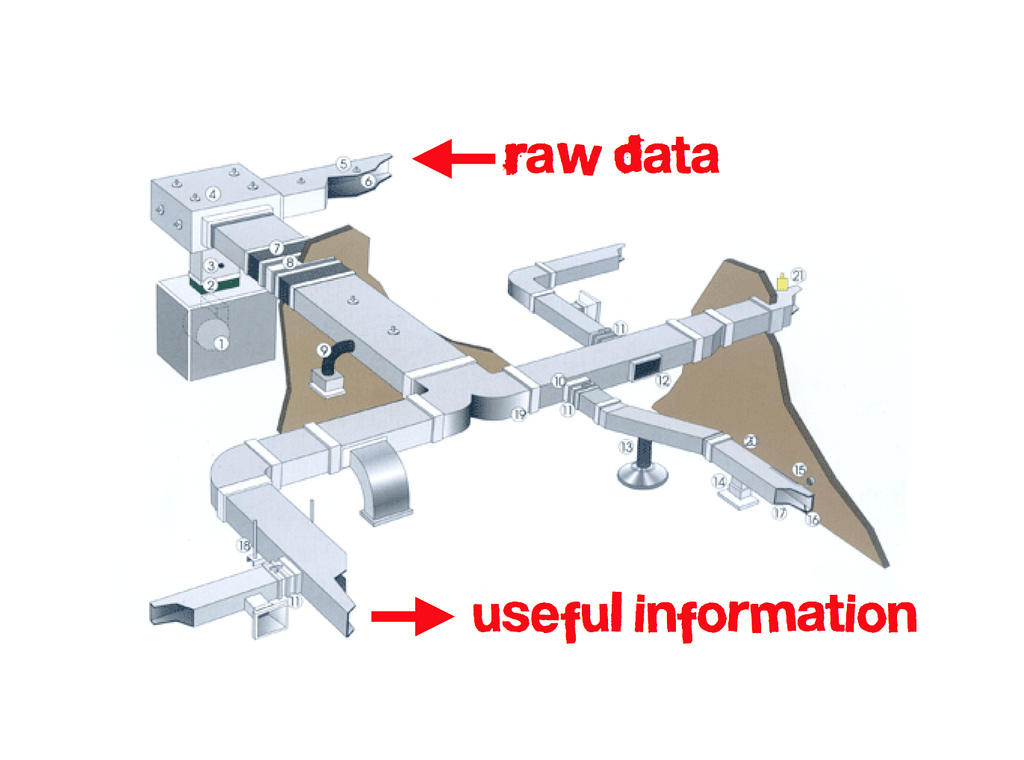
Although the slides for my talk won’t make a lot of sense without the witty banter overlaid on top of them, here they are for posterity.
The breakfast clubbers asked some good questions, I enjoyed a cup of luke-warm hotel coffee, and by 9:00 a.m. I was on my way back to the office.
There’s a lot to love about Sushi Jeju, the Korean-Japanese-Indian restaurant you’ve never been to located next to the Best Western on Grafton Street in Charlottetown, including a fantastic new Indian Fried Rice dish on the menu that took my breath away.
But my favorite part of tonight’s meal was at the very end when the chef said, as we were on our way out the door, “we’ll see you again on… Wednesday.” Marketing through pre-ordination? Careful observation of my restaurant habits? Whatever you call it, like the fried rice, it’s a new sort of flavor for Charlottetown.
Highly recommended..
 On the CBC At Issue panel on The National last night most of the time was taken up with discussion of a “CROP poll,” to be reported in La Presse today, showing an “NDP surge.” Host Peter Mansbridge introduced the topic to the panel like this:
On the CBC At Issue panel on The National last night most of the time was taken up with discussion of a “CROP poll,” to be reported in La Presse today, showing an “NDP surge.” Host Peter Mansbridge introduced the topic to the panel like this:
There’s one that we’re hearing rumblings about tonight – this is a poll – and while we don’t place a lot of faith in polls you can guarantee this is going to make big news tomorrow. A poll, a CROP poll, a very highly respected organization, that’s going to suggest that the NDP, at least at the time the poll was done, were in first place – yes, you’re hearing me right – first place in Quebec, ahead of the Bloc Quebecois.
And for the following seven minutes much of the discussion of the panel was about or in reaction to this poll.
If, in fact, this was an actual poll as we were led to believe by the CBC panel, this would indeed be a big deal; it wasn’t until I returned to the topic this morning through an article in the Toronto Star, NDP jumps ahead of Bloc in Quebec: Poll, that I read, way down in the last paragraph:
The survey of 1,000 Quebecers online took place between April 13 and 20. Due to its non-random character, there is no margin of error.
This is echoed in La Presse in its article Le NPD prend la tête au Québec:
Ce sondage mené en ligne ne comporte pas de marge d’erreur compte tenu du caractère non probabiliste de l’échantillon.
In its reporting today the CBC has changed the language from “poll” to “online survey.” For example, in Bloc changes tactics to deal with NDP surge they report:
An online survey done by CROP, which the company said cannot be assigned a margin of error because the methodology doesn’t allow for random sampling, shook up the race in Quebec overnight Thursday, showing a surge for the NDP.
Note that although the language has changed, and the description of the methodology is closer to the lede, the headline is still a reference to a “surge” that exists only because of the “online survey.”
None of the stories I’ve been able to find dive any deeper than that, and we’re left not knowing whether the “online survey” was simply a web poll, liable to “poll box stuffing” by anyone who happened to come across it, or if it involved any sort of more statistically valid methodology.
What really bothers me about this issue, however, is that I’ve been impressed with the lack of coverage on The National – my primary source of election news and opinions – of polls for this federal election. Whether through policy or circumstance the CBC has devoted little or no coverage to the game of polling, and has instead concentrated on, dare I say, the ideas of the campaign. For this trend to be broken by giving substance to something that, on the surface, seems so potentially inaccurate is unfortunate and misleading.
As a fan of timelines and data visualizing, I’ve been delighting in Memolane since they released their first beta. This week they added the ability to embed timelines, and the result is this:
(I used to have the embedded Memolane widget here, but I didn’t like how long it was taking to load, so I removed it; you can still see the real thing right here.)
Charlottetown residents awoke on December 11, 2007 to stories on the CBC – 10-storey hotel to be P.E.I.’s tallest building – and in The Guardian – Huge hotel in the works – about a new hotel coming to the heart of the city and that, in its meeting the night before, City Council had unanimously passed a resolution to allow the new hotel to be built 87 feet higher than planning regulations allowed:
That the application for a height variance from the required 39.4 feet to approximately 127 feet, and for off-lot parking and/or cash-in-lieu of parking, for the proposed hotel to be constructed at 172-180 Queen Street by Dyne Holdings Limited, subject to the Developer entering into a Development Agreement for this project, be approved (draft agreement attached and to be reviewed by the City Solicitor).
Note that the approval was for a hotel to be built at 172-180 Queen Street, a location, at the time, occupied by a vacant lot and by The Bookmark that looked much like this (photo from Google Maps):

A year later, in November of 2008, we learned what the hotel, still planned for that lot on Queen Street, was going to look like, from an article that appeared in The Guardian:
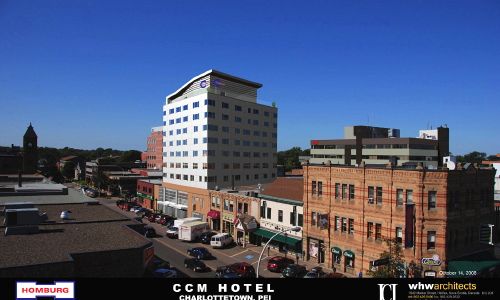
Two months later, on January 7, 2009, came a story in The Guardian that the hotel’s planned site might move:
The proposed move wouldn’t take the hotel far. It would remain inside the block which houses Confederation Court Mall but instead of fronting Queen Street, as the current proposal lists, it would look out onto Grafton Street.
The story placed the possibility of a move in the context of a law suit by the hotel’s developer, Homburg Invest, against a neighboring property owner:
Homburg Invest. Inc., which announced in late November intentions to spend $45 million on a three-phase development project in the capital, is currently embroiled in a $5-million lawsuit against property owners in Charlottetown. Homburg has launched the suit against 2950243 Canada Inc., 100946 P.E.I. Inc., Nemir Tweel Corp. Ltd. and Christopher Tweel. “The properties owned by 2950243, 100946 and/or Nemir Tweel (collectively ‘The Tweel Properties’), border upon, or are in close proximity to the plaintiff’s properties,” Homburg, the plaintiff, says in the lawsuit. One of those properties is the vacant lot next to the TD Dominion Bank on Queen Street. In order to use that property, Homburg would need to reach an agreement with the Tweels.
Sure enough, in a meeting of January 22, 2009, City Council unanimously approved another variance related to the hotel:
That the application for a height variance from the required 39.4 feet to approximately 127 feet, and for cash-in-lieu of parking, for the proposed hotel to be constructed at 123-125 Grafton Street (PID#s 342311 & 342329), subject to the Developer entering into a Development Agreement for this project, be approved.
The CBC report of this new development concentrated on the variance and the lawsuit, and the move around the corner to Grafton Street was mentioned only in the last paragraph:
Homburg’s dispute with Tweel has already led the company to reconfigure the hotel so its entrance is on Grafton Street. The original plan called for an entrance on a vacant lot owned by Tweel on Queen Street.
In the same article we learned what the newly-configured hotel was going to look like, with the clear suggestion of two design elements: a mosaic of anodized aluminum panels of differing shades on the upper portion and a completely-preserved facade of the former Holman’s location that was to be torn down to make way for the hotel:
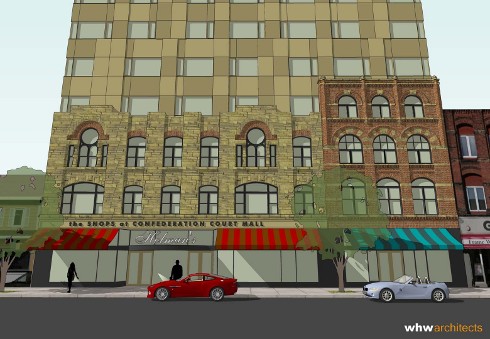
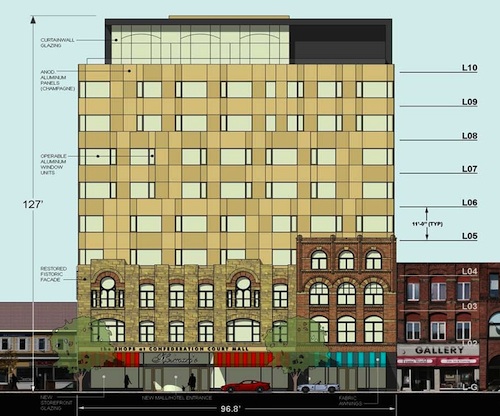
When work on the site began in April of 2009, the preservation of the facade was confirmed in an article in The Guardian:
Cliff Campbell, of James C. Johnson Associates Inc., says the fact the Holman building is over 100 years old means there are a lot of steps that need to be taken first before any major demolition occurs. He said the building, which once housed 10 businesses and acted as one of four main entrances to The Shops of Confederation Court Mall, will start to make its way to the ground over the next few months and will be reconstructed into the first new hotel development in downtown Charlottetown in over 25 years. With the historic brick starting to peek through, crews will be working to reinstate this portion of the Holman Building and keep it as part of the new development. “By keeping this part of the existing building, the historic feel of downtown Charlottetown will remain as well as this portion of the originally built Holman Building,” says a company news release.
A month later the modern-day cladding on the Holman Building was peeled off to reveal the facade that was to be preserved:
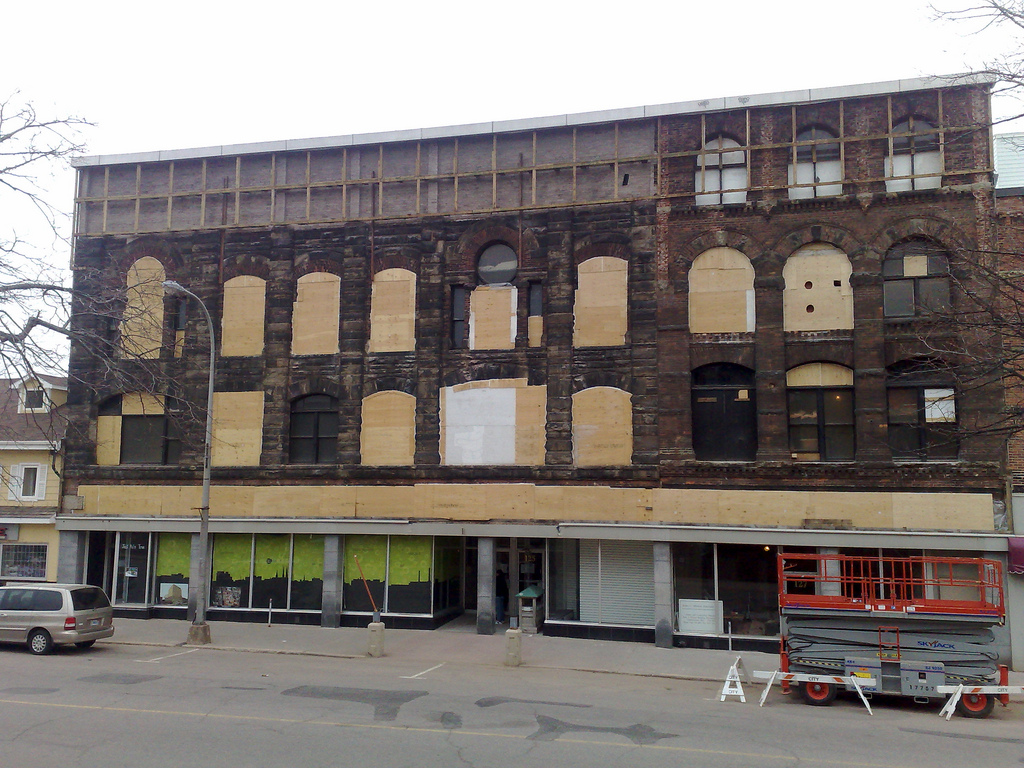
That photo, from May 9, 2009, clearly shows two sections to the facade: on the left is sandstone with minimal red brick in-fill and on the right is an all-brick section extending one floor higher.
Construction continued on the new hotel over the balance of 2009 and through 2010 interrupted only by comments in November 2010 from lawyer and historian James Macnutt, covered by the CBC as Hotel dominates P.E.I.’s Province House: author, that the new hotel was looming too large over Queens Square:
“I’m deeply disappointed. I think the citizens of Charlottetown should be deeply disappointed that that building was allowed to go there,” said Macnutt. “It is inappropriate in the location: its scale, its mass, its overall appearance.”
Mr. Macnutt’s comments echoed parts of his submission earlier in the fall to hearings held under Motion 56: The Future of Province House and neither appeared to attract significant public outcry.
Over the winter of 2010-2011 the new building was closed in, and in early February we got the first taste of what the cladding on the upper part of the hotel was going to look like:
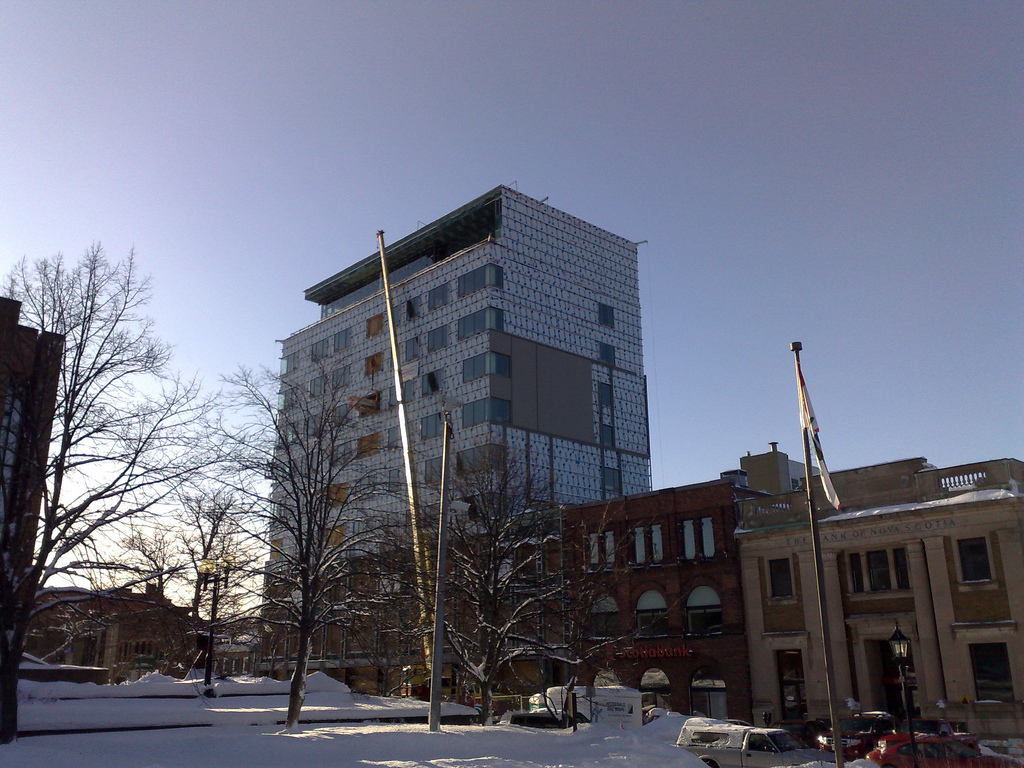
It seemed that the “mosaic” of alternating colours of anodized aluminum that had been shown in every rendering of the hotel to date was to give way to a single colour of beige aluminum siding. Here’s a close-up of what’s been going up on the outside of the building all spring long:

As of today, it appears as though this is, in fact, what’s going to cover the entire upper facade of the hotel:
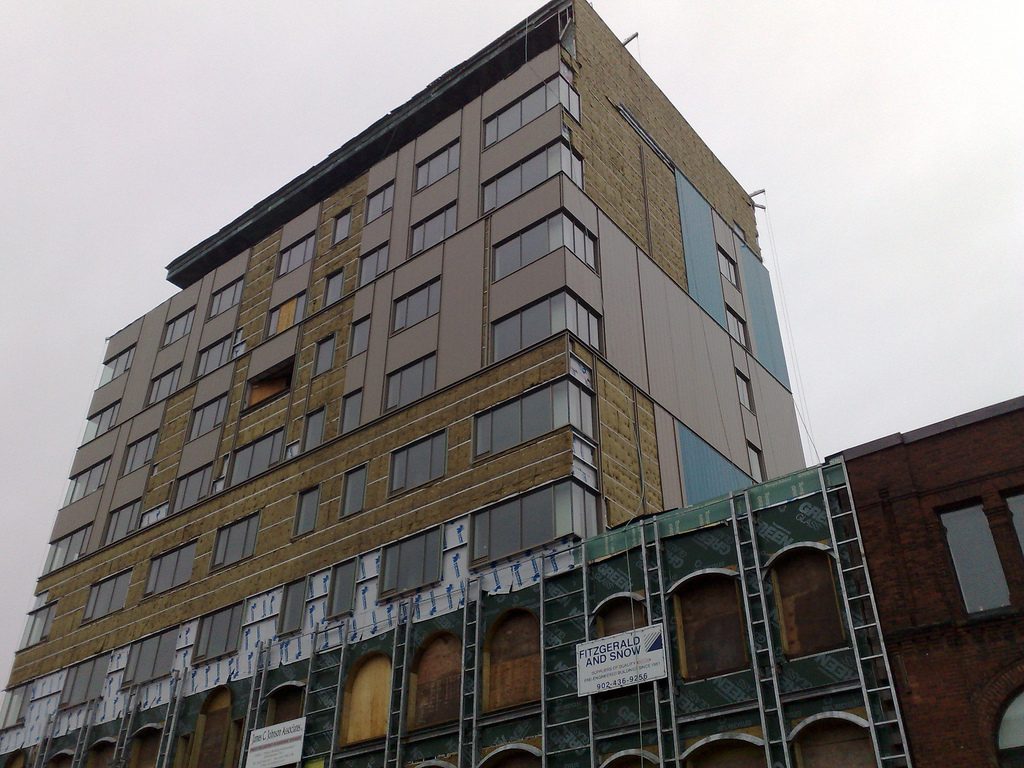
I wondered if perhaps this could be some sort of “under-layer” that would, as construction proceeded, would be enhanced with additional design detail, but in recent publicity for the hotel, now named the Holman Grand, the rendering of the hotel has been substantially changed from what’s been used to date. In a PDF fact sheet, for example, is this new rendering:
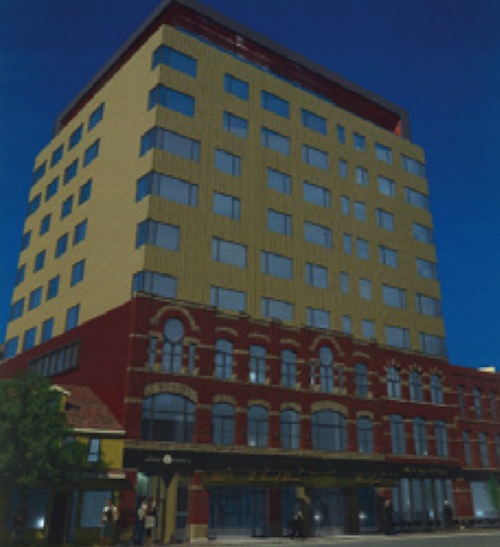
Notice how the previously textured upper portion of the exterior has given way to a monotone.
And note, additionally, that the sandstone from the lower part of the exterior, sandstone we were once told “crews will be working to reinstate … as part of the new development,” has given way to a completely red brick exterior, with sandstone highlights, so that there appears to be little remaining of the original facade, and also that the far-right of the lower exterior no longer extends into the fourth floor as it was once shown.
The result? We thought we were getting the hotel on the left and inside we’re getting the hotel on the right:
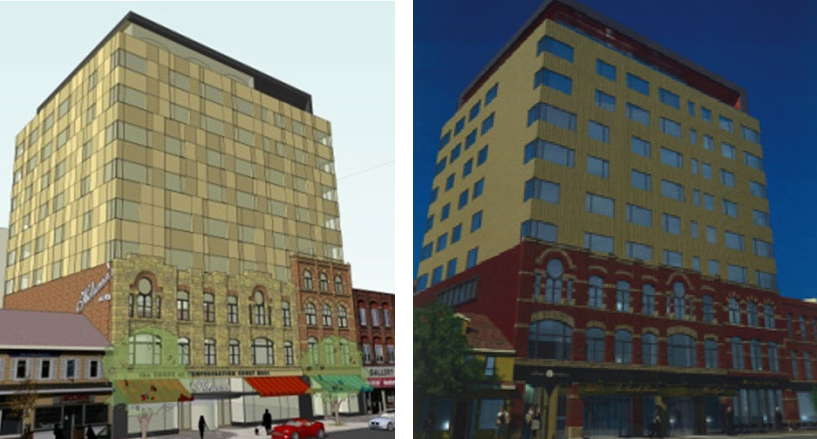
It’s not news that I’ve been opposed to much of what Homburg Invest has developed in Charlottetown in recent years, including this hotel; setting my aesthetic and urban planning opinions aside, though, it seems as though planning regulations in the city should work to ensure, at the very least, that developers build what they say they’re going to build, especially in cases like this where the very fabric of downtown Charlottetown is being remade.
If City Council approved variances to planning regulation based on one design for the hotel and we end up with a substantially changed design, something’s broken.
Remember the work I did a few weeks ago to serve up Prince Edward Island to New Brunswick energy interchange in an open format via Pachube?
It seemed like a good idea unlock data on regulated petroleum prices trapped inside Island Regulatory and Appeals Commission HTML in a similar fashion.
So I’ve created some PHP code to scrape the data out of the HTML and into XML, JSON or Pachube-friendly formats and a Pachube feed the uses this code. The result of all this means that you can programmatically pull current gasoline prices from Pachube and use the data to build new and interesting applications.
I got an email from Google this morning announcing that video I’d uploaded over the years to Google Video, a service that in the pre-YouTube acquisition was Google’s competing video hosting service, would be removed after May 13th.
I hadn’t used Google Video for so long that I’d forgotten it even existed, and that I had some video there that I didn’t have stored elsewhere. But I did. So I logged in and downloaded them all, as my Google email suggested. Here’s a selection of what I found feature then-wee Oliver (note to parents: shoot video of your kids before they grow up; I wish I’d shot more):
At the beginning of every day’s proceedings in the Legislative Assembly of Prince Edward Island is a period called Matters of Privilege and Recognition of Guests, an opportunity for members to speak to anything from congratulating their local curling rink for a win to recognizing visitors in the public gallery. To the uninitiated it is perhaps the weirdest part of the house proceedings, mostly because it actually doesn’t seem to have much to do with the important matters of the day. But it’s a tradition and I’ve come to view it as a part of the social fabric of Island politics.
On Tuesday morning I got an email from the Executive Director of the PEI Home and School Federation suggesting that I drop down to the Legislature that afternoon to watch Hon. Doug Currie deliver a statement on education governance. As the Statements by Ministers period doesn’t happen until after Question Period, we in the public gallery who arrived at the 2:00 p.m. opening got to see a lot of house business before Minister Currie’s statement, and I had the odd experience of being recognized three times during Matters of Privilege and Recognition of Guests. First came Hon. Robert Ghiz:
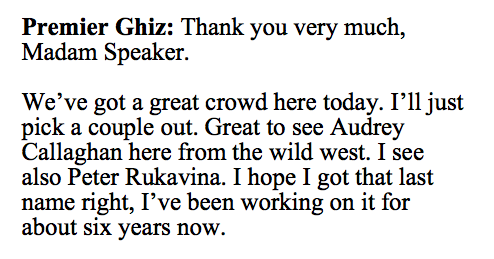
And then, a few minutes later, by Cynthia Dunsford, an old friend from her pre-political days:
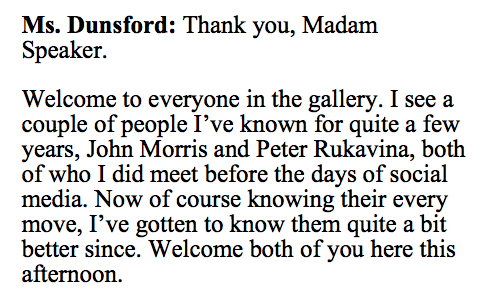
And finally Hon. Doug Currie (who happens to have the longest title I’ve ever encountered: Minister, Education and Early Childhood Development and Justice and Public Safety):
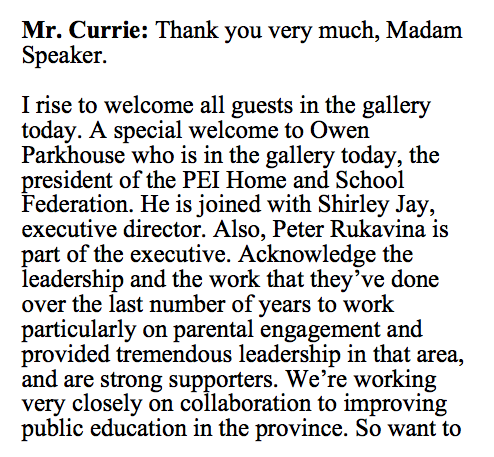
I should hasten to add that I am neither a Liberal nor, indeed, anything but politically agnostic: almost everyone who sits in the public gallery gets recognized – there were only about a dozen of us on Tuesday, so it’s not a hard feat to accomplish.
That said, I to feel like achieving this hat trick has leveled me up to a new plateau on the path to Islanderhood, and I’m fully expecting to get an envelope slipped under my door with the passwords to the secret ceilidhs any day now.
In this well-produced video about the U.S. budget, U.S. Congressman Paul Ryan says “I asked the Congressional Budget Office to model the economy going forward, so they have these computer programs that simulate the U.S. economy; the computer program crashes in 2037 because it can’t conceive of any way in which the U.S. economy can continue because of this massive burden of debt.”
This may very well be true. But I’m wondering whether the simulator might be crashing, instead, because of the well-known 2038 problem, described in Wikipedia like this:
The year 2038 problem (also known as the Unix Millennium Bug, Y2K38, Y2.038K, or S2G by analogy to the Y2K problem) may cause some computer software to fail at some point near the year 2038. The problem affects all software and systems that both store system time as a signed 32-bit integer, and interpret this number as the number of seconds since 00:00:00 UTC on Thursday, 1 January 1970. The furthest time that can be represented this way is 03:14:07 UTC on Tuesday, 19 January 2038. Times beyond this moment will “wrap around” and be stored internally as a negative number, which these systems will interpret as a date in 1901 rather than 2038. This is caused by Integer overflow. The counter “runs out” of usable digits, “increments” the sign bit instead, and reports a maximally negative number (continuing to count up, towards zero). This will likely cause problems for users of these systems due to erroneous calculations.
I’ve no idea whether this is the case, but hearing “2037” and “crash” invoked in the video has got me wondering.
Earlier in the day I mentioned the abysmal state of schedule information for East Coast Music week here in Charlottetown. But way of helping mitigate this a little, I’ve taken the information for the two events, Discovery Stage and MIAFest, and have created a Google Calendar for them that you can grab and integrate into your digital lifestyle in a variety of ways:
You’d think that this sort of “open data for public events” would be an expected part of organizing any event these days, but even at the hippest of tech conferences it often seems to be left out, and what we’re left with is graphic artists’ impressions of usefulness.
These are obviously very unofficial calendars, subject to be completely wrong or out of date.
The nice thing about having the data in open formats is that the data is free to flow wherever it may; here’s the iCal file on my iPad, for example:

I can set alarms, send invites to friends, and generally arrange my musical week in an environment that I’m comfortable with.
 I am
I am